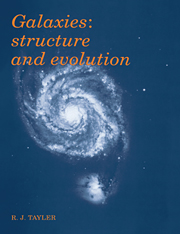Book contents
- Frontmatter
- Contents
- Preface
- Symbols
- Numerical values
- 1 Introduction
- 2 Observations of the Galaxy
- 3 Properties of external galaxies
- 4 Stellar dynamics
- 5 Masses of galaxies
- 6 The interstellar medium in our Galaxy
- 7 The chemical evolution of galaxies
- 8 Galaxies and the Universe
- 9 Concluding remarks
- Appendix 1 Some factors influencing stellar spectra
- Appendix 2 The Virial Theorem
- Appendix 3 Gravitational fields due to spheres and ellipsoids
- Suggestions for further reading
- Index
3 - Properties of external galaxies
Published online by Cambridge University Press: 05 June 2012
- Frontmatter
- Contents
- Preface
- Symbols
- Numerical values
- 1 Introduction
- 2 Observations of the Galaxy
- 3 Properties of external galaxies
- 4 Stellar dynamics
- 5 Masses of galaxies
- 6 The interstellar medium in our Galaxy
- 7 The chemical evolution of galaxies
- 8 Galaxies and the Universe
- 9 Concluding remarks
- Appendix 1 Some factors influencing stellar spectra
- Appendix 2 The Virial Theorem
- Appendix 3 Gravitational fields due to spheres and ellipsoids
- Suggestions for further reading
- Index
Summary
Introduction: the Hubble classification of galaxies
In the preceding chapter I have discussed in considerable detail the properties of one individual galaxy – the Galaxy. In this chapter I discuss other galaxies (external galaxies) and I compare and contrast their properties with those of the Galaxy. The easiest property of a galaxy to discuss is its visual appearance. Soon after the existence of external galaxies had been established in the early 1920s it was realised that galaxies of regular shape could be divided into two main classes, spiral galaxies and elliptical galaxies. Subsequently it was realised that the spirals should be subdivided into ordinary spirals and barred spirals and that a further class known as lenticular galaxies should be introduced. In addition there were irregulars, galaxies possessing no obvious symmetry. In the 1930s Hubble introduced his classification of galactic types which, with some modifications, is still used today.
The simplest version of the Hubble classification is illustrated in fig. 33. At the time that Hubble introduced the classification, he thought that it might represent an evolutionary sequence with galaxies possibly evolving from elliptical to spiral form but, as we shall see later, that is not believed to be true today. There are alternative classifications of galaxies in use but the Hubble system is essentially adequate for the present book. There is one important group of galaxies which was not known to Hubble because its members are rare and the nearest one is a very large distance from the Galaxy.
- Type
- Chapter
- Information
- GalaxiesStructure and Evolution, pp. 52 - 88Publisher: Cambridge University PressPrint publication year: 1993

